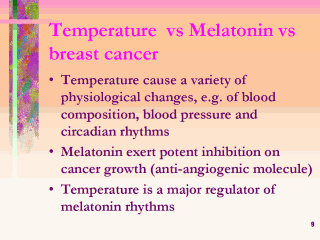 |
Temperatures cause
a variety of physiological changes, e.g. of blood composition, blood
pressure 9 and circadian rhythms 10, which in turn are
believed to contribute to an increased mortality/incidence of breast cancer
11,12,13,14. Published laboratory studies have reported that
melatonin might have cancer-preventive activities 11,12,13,14.
Melatonin has been observed to exert potent inhibition on cancer growth by
acting as natural anti-angiogenic molecule, with a following opposition or
angiogenesis-dependent cancer proliferation 15. This has been
demonstrated in certain human breast cancer cell lines such as MCF-7, with
additional in-vivo effects on breast oncogenesis in various rat models
15. Melatonin (N-acetyl-5-methoxytryptamine) is a hormone
secreted by the pineal gland of vertebrates, which controls several
physiological functions associated with circadian rhythm 10,16.
Temperature is a major regulator of circadian rhythms 16.
Circadian rhythms control many physiological activities. Synchronization of
biological clocks to environmental time is adaptive and important for
physiological homeostasis and for the proper timing of species-specific
behaviors 17. A number of investigations have been conducted to
examine the effects of temperature and light on melatonin rhythms 18,
see Table V. Based on our analysis, we proposed a second order equation (y
= a + bx + cx2 ) to describe the correlation between the
average temperature and mortality rates. This model was best described the
relationship between the two parameters. Based on this model, the estimated
temperature (Te) values at which the mortality rates are
low is in the range 49< Te
< 11° C. |
